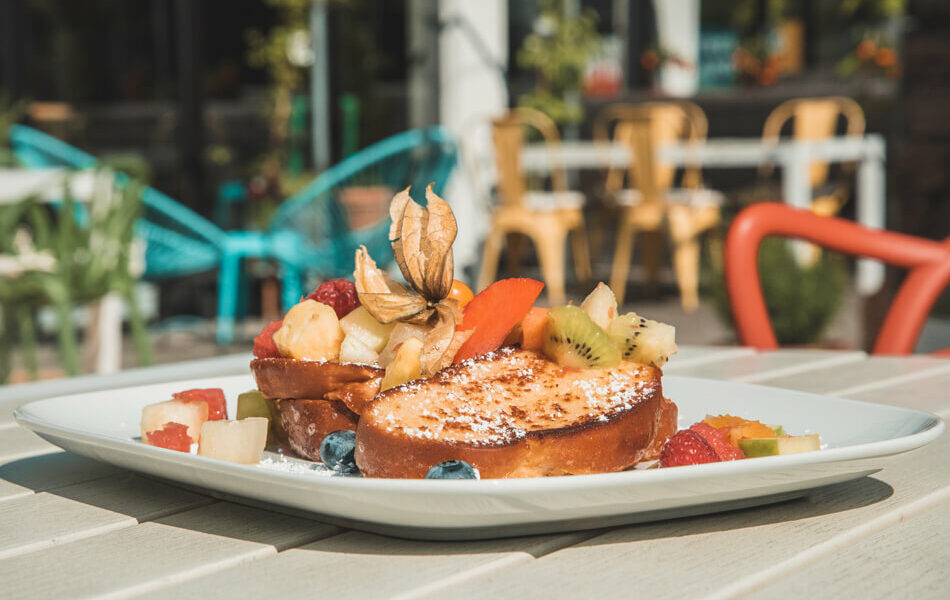Is French Toast Healthy? Nutrition Breakdown + Healthier Recipe
French toast is a popular breakfast favorite, often topped with maple syrup and fruit. However, many often wondered about its nutritional value.

French toast is a starchy breakfast dish many around the world love to enjoy. It is a comforting, tasty dessert-like meal.
Many eat French toast with an abundance of maple syrup, chocolate sauces, and whipped cream.
Therefore, you may understand it can be high in sugar and fat, especially due to some of the sweet toppings. However, you might wonder: are there ways to make your French toast more nutritious and decrease the caloric value?
Read on to learn more about the benefits and drawbacks of eating French toast.
Is French Toast Healthy?
Yes and no, French toast is high in calories, carbohydrates, and added sugar. To make your toast healthier, substitute wheat bread instead of white bread, fresh or frozen fruit instead of maple syrup, and more.
Is French Toast Good for Weight Loss?
French toast is not the best breakfast option for weight loss. Since French toast is made primarily of white bread, it is high in calories, carbohydrates, and sugar.
However, there are some substitutes you can make to increase the nutrition of the breakfast meal – more on this below.
Healthy French Toast Recipe
French toast is bread soaked in an egg and milk mixture and then fried in a pan on the stovetop. Let’s break down how to make a healthier French toast recipe.
#1 Choose whole-grain bread
To make healthy French toast, start with your favorite brand of whole-grain bread. Whole-grain bread has much more fiber than white bread.
If you have a gluten allergy or intolerance, you can substitute whole-wheat bread with gluten-free bread.
#2 Make the egg mixture
Make an egg mixture by whisking together eggs and low-fat milk. You can also use a non-dairy milk alternative such as cashew, soy, or almond milk.
Add some spices to the egg mixture, such as cinnamon, nutmeg, and even vanilla extract, to boost the flavor and promote additional health benefits.
#3 Use the right cooking oil
Many prefer to fry their toast in fats such as butter or coconut oil. However, these oils, like coconut oil, are high in saturated fat, which can contribute to heart disease.
Therefore, it’s best to use light olive oil or avocado oil. These oils are much lower in saturated fat than butter or other cooking oils and have a mild flavor that won’t overpower the flavor of the French toast.
Place a slice of the bread in the bowl with the liquid egg mixture and let it soak for about 10–15 seconds before flipping it over and repeating the process.
Move the bread that has been soaked in the egg mixture to an oiled frying pan on low heat.
Cook the bread until golden brown, then flip, let that side cook, and serve.
What Are the Healthiest French Toast Toppings?
Many enjoy topping their dish with maple syrup, whipped cream, butter, chocolate syrup, or caramel. However, there are some healthier foods you can add instead.
#1 Natural sweeteners
To still get that sweet flavor that you likely associate with the delicious toast, use a natural sweetener, including honey, blue agave nectar, or 100% pure maple syrup. While these choices of sweeteners still have sugar, they also contain beneficial nutrients.
Furthermore, to make healthy French toast, you can top it with sugar-free maple syrup to reduce the sugar content even more.
#2 Fresh fruit
Add cut-up pieces of fresh or frozen fruit such as bananas, berries, and melon to add sweetness, vitamins, and minerals to your French toast. Additionally, adding fruit can also help incorporate dietary fiber into your breakfast.
According to the Mayo Clinic, dietary fiber is essential for a healthy digestive tract and can lower cholesterol and blood sugar levels.
#3 Protein
Additionally, you could top it with Greek yogurt and granola. The granola can provide some whole grain and fiber, while the Greek yogurt can provide probiotics, calcium, and protein.
Including protein and fiber in your breakfast helps make just a slice or two more filling, satisfying, and energizing.
Pair your breakfast with a glass of milk or a non-dairy milk alternative to boost the protein, vitamin D, and calcium content.
French Toast Nutritional Facts
Let’s dive into the nutritional information of a serving of French toast.
Nutritional table (per 100g)
| Calories/Nutrient | Amount |
| Calories (Kcal) | 272 |
| Net Carbs (g) | 32.2 |
| Fibers (g) | 1.2 |
| Sugars (g) | 10.1 |
| Fats (Total) | 11.2 |
| Protein (g) | 10.4 |
| Cholesterol (mg) | 160 |
| Sodium (mg) | 323 |
Source: https://fdc.nal.usda.gov/fdc-app.html#/food-details/1101493/nutrients
High in calories
A 100g serving of French toast containing approximately one and a half slices of bread contains 272 calories. Remember that this information is for plain toast without toppings.
Adding sugary toppings such as whipped cream, maple syrup, and chocolate sauce can increase the caloric value even more.
Therefore, French toast is high in calories, especially compared to other breakfast choices such as yogurt and granola or an omelet.
However, if the healthy French toast is made with wheat bread, low-fat dairy (or non-dairy milk, such as almond milk), and instead has fresh fruit as a topping, it will be more filling and nutritious, and you will be full after eating less of it.
High in vitamins and minerals
Bread, including white bread often used for French toast, is rich in B vitamins that help chemical reactions in the body occur. However, rather than occurring naturally, most B vitamins are added to bread during processing, also known as fortification.
Bread is especially high in thiamine or vitamin B1. According to the Harvard School of Public Health, vitamin B1 plays a role in cell functioning and growth. Unfortunately, the liver holds only tiny amounts of thiamine, so it must be consumed daily.
Another B vitamin in bread is riboflavin or vitamin B2. Like vitamin B1, riboflavin supports healthy cell growth, helps produce body energy, and breaks down and metabolizes fats.
Finally, another essential nutrient in bread is niacin or vitamin B3. Niacin is an antioxidant that helps protect cells in the body from free radicals. Additionally, niacin helps produce and repair genetic material and DNA.
High in saturated fat
French toast has about 3.5g of saturated fat per 100g serving (approximately one and a half slices of bread).
Saturated fat is typically found in animal products; therefore, the high amount of fat here is likely due to the milk and eggs.
Saturated fat can also come from the cooking process if the toast is prepared in a high-fat oil, such as coconut oil.
High in carbs
Since French toast is bread-based, it contains a significant amount of carbohydrates. Specifically, it has 32.2g of carbs in a serving of 100g.
Carbohydrates are the body’s primary energy source and are essential for proper functioning, including that healthy brain function.
However, if you want to reduce the carbohydrates you consume, stick with just a slice or two of bread. Additionally, consume French toast in moderation since it can also be high in sugar.
A moderate amount of sodium
Based on the United States Department of Agriculture food database, a 100g serving of French toast has over 300mg of sodium.
Often it is high in sodium because sodium is a preservative used to extend the shelf-life of items at the grocery store. However, if you are making your breakfast at home, it will have a lot less sodium than store-bought frozen versions, including French toast sticks.
The American Heart Association recommends consuming no more than 2,300mg of sodium daily for overall health. However, it is ideal to finish closer to 1,500mg daily instead.
A diet with excess sodium can contribute to heart disease, including high blood pressure, heart attack, and stroke.
High in cholesterol
Finally, French toast is high in cholesterol, with 160mg per 100g serving. Cholesterol comes from animal products and mainly comes from the eggs.
The 2020–2025 Dietary Guidelines for Americans recommend consuming as little cholesterol as possible as a healthy and balanced diet.
A Word From a Dietitian
Overall, French toast is an energy-dense, also known as a calorie-dense, food because it has low amounts of nutrients per calorie it contains.
Traditional French toast is white bread soaked in egg and milk and fried in a pan on the stovetop. However, if you substitute whole-wheat bread for white bread, you significantly boost your nutrition, including dietary fiber.
Additionally, skip the sugary breakfast toppings such as chocolate, maple syrup, and whipped cream. Instead, top your healthy French toast with fresh fruit, yogurt, and granola to get even more fiber, protein, vitamins, and minerals.
Finally, if you make French toast at home, substitute the milk choice with a low-fat or skim dairy option or a low-fat non-dairy milk alternative, such as unsweetened almond milk.
FAQ
French toast can be part of a healthy diet if consumed in moderation or prepared with whole-grain bread and served with nutrient-rich toppings, such as fresh fruit or nut butter.
No. French toast is typically made with white bread and is fried in butter or oil, making it a high-calorie, high-fat breakfast option. It also spikes your blood sugar levels quickly, providing a short-term energy boost but not sustained energy throughout the day.
Yes, French toast is generally considered to be a high-calorie and high-fat food. However, it can be made in a healthier way by using whole-grain bread, low-fat milk, and low-sugar toppings.
Conclusion
French toast is a food to be enjoyed in moderation, but it is even better to opt for whole-wheat toast with avocado, salmon, or other savory toppings in it.
However, using the substitutions mentioned in this article, you can also add some nutrition to your French toast.

















































 Select your language:
Select your language: 








